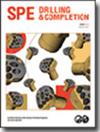Combining Magnetic and Gyroscopic Surveys Provides the Best Possible Accuracy
IF 1.2
4区 工程技术
Q3 ENGINEERING, PETROLEUM
引用次数: 0
Abstract
Summary A survey program is designed for every well drilled to meet the well objective of penetrating the target reservoir and avoiding a collision with nearby offset wells. The selection of the wellbore survey tools within the survey program is limited in number and accuracy by the current surveying technologies available in the industry. This article demonstrates how a higher level of accuracy can be achieved to meet challenging well objectives when the accuracy of the most accurate wellbore surveying tools and technologies taken individually is insufficient. This high level of wellbore positioning accuracy is achieved by combining two independent wellbore positions of the same wellbore trajectory. The first wellbore position is calculated using the latest technology of magnetic measurement-while-drilling (MWD) definitive dynamic surveys (DDS). The accuracy of the MWD DDS can be further improved by minimizing error sources such as misalignment of the survey package from the borehole, drillstring magnetic interference, the use of localized geomagnetic reference, using high-accuracy accelerometer sensors, and a high-accuracy gravity reference. Furthermore, the MWD DDS inclination accuracy is improved using an independent inclination measurement from the rotary steerable system. A first wellbore position is calculated from the magnetic MWD DDS after applying in-field referencing (IFR), multistation analysis (MSA), bottomhole assembly (BHA), sag correction (SAG), and dual-inclination (DI) corrections to improve both azimuth and inclination accuracy. A second wellbore position is calculated using gyro-MWD (GWD) technology. The results and comparisons of multiple combined survey runs are presented. The highest accuracy of wellbore positioning had been proved in this successful case study by penetrating a very small reservoir target on an extended-reach well that was unfeasible using either the most accurate enhanced MWD DDS or GWD technology individually. The presented case study shows how the wellbore objectives of penetrating a very small reservoir target had been confirmed by logging-while-drilling images and the reservoir mapping interpretation of the client subsurface team. This gave a high-accuracy wellbore position during drilling and provided higher confidence in wellbore placement to maximize reservoir production without colliding with nearby offset wells. Wellbore survey accuracy limits a borehole’s lateral and true vertical depth (TVD) spacing, constraining reservoir production in those sections. In the top and intermediate sections, wellbore survey accuracy limits how close the wellbore can be drilled to other offset wells due to collision concerns. This directly impacts the complexity of the directional work and the cost per section. Combining independent wellbore surveys unlocks the potential to improve the wellbore positioning accuracy significantly. It demonstrates the highest wellbore positioning accuracy that can be achieved to date compared with the latest magnetic MWD surveys after correcting all known errors or compared with GWD.结合磁和陀螺仪测量提供最好的可能的精度
为满足钻透目标储层和避免与附近邻井发生碰撞的井目标,每口井都设计了一套测量方案。由于目前行业中可用的测量技术,在测量程序中,井眼测量工具的选择在数量和精度上都受到限制。本文展示了当最精确的井筒测量工具和技术的精度不足时,如何实现更高的精度,以满足具有挑战性的井目标。这种高水平的井眼定位精度是通过结合相同井眼轨迹的两个独立井眼位置来实现的。第一个井眼位置是使用最新的随钻磁测量(MWD)确定动态测量(DDS)技术计算的。通过最大限度地减少误差源,如测量包与井眼的不对准、钻柱的磁干扰、使用局部地磁参考、使用高精度加速度计传感器和高精度重力参考,可以进一步提高MWD DDS的精度。此外,利用旋转导向系统的独立倾角测量,MWD DDS的倾角精度得到了提高。在应用现场参考(IFR)、多站分析(MSA)、底部钻具组合(BHA)、凹陷校正(sag)和双倾角校正(DI)以提高方位和倾角精度之后,通过磁性MWD DDS计算出第一个井眼位置。使用陀螺仪随钻测量(GWD)技术计算第二个井眼位置。给出了多次联合调查的结果和比较。在这个成功的案例研究中,通过在大位移井中穿透一个非常小的储层目标,证明了井眼定位的最高精度,这是单独使用最精确的MWD DDS或GWD技术都无法实现的。该案例研究展示了如何通过随钻测井图像和客户地下团队的储层图解释来确定穿透非常小的储层目标的井筒目标。这在钻井过程中提供了高精度的井眼位置,并提供了更高的信心,以最大限度地提高油藏产量,而不会与附近的邻井发生碰撞。井眼测量精度限制了井眼的水平和真垂直深度(TVD)间距,限制了这些段的油藏产量。在顶部和中间段,由于碰撞问题,井眼测量精度限制了井眼与其他邻井的距离。这直接影响了定向作业的复杂性和每段的成本。结合独立的井筒测量,可以显著提高井筒定位精度。在修正了所有已知误差后,与最新的磁随钻测量或与GWD相比,它证明了迄今为止可以实现的最高井筒定位精度。
本文章由计算机程序翻译,如有差异,请以英文原文为准。
求助全文
约1分钟内获得全文
求助全文
来源期刊

SPE Drilling & Completion
工程技术-工程:石油
CiteScore
4.20
自引率
7.10%
发文量
29
审稿时长
6-12 weeks
期刊介绍:
Covers horizontal and directional drilling, drilling fluids, bit technology, sand control, perforating, cementing, well control, completions and drilling operations.
 求助内容:
求助内容: 应助结果提醒方式:
应助结果提醒方式:


